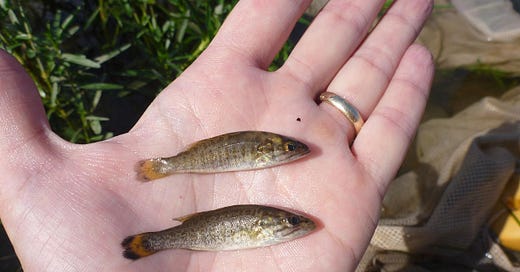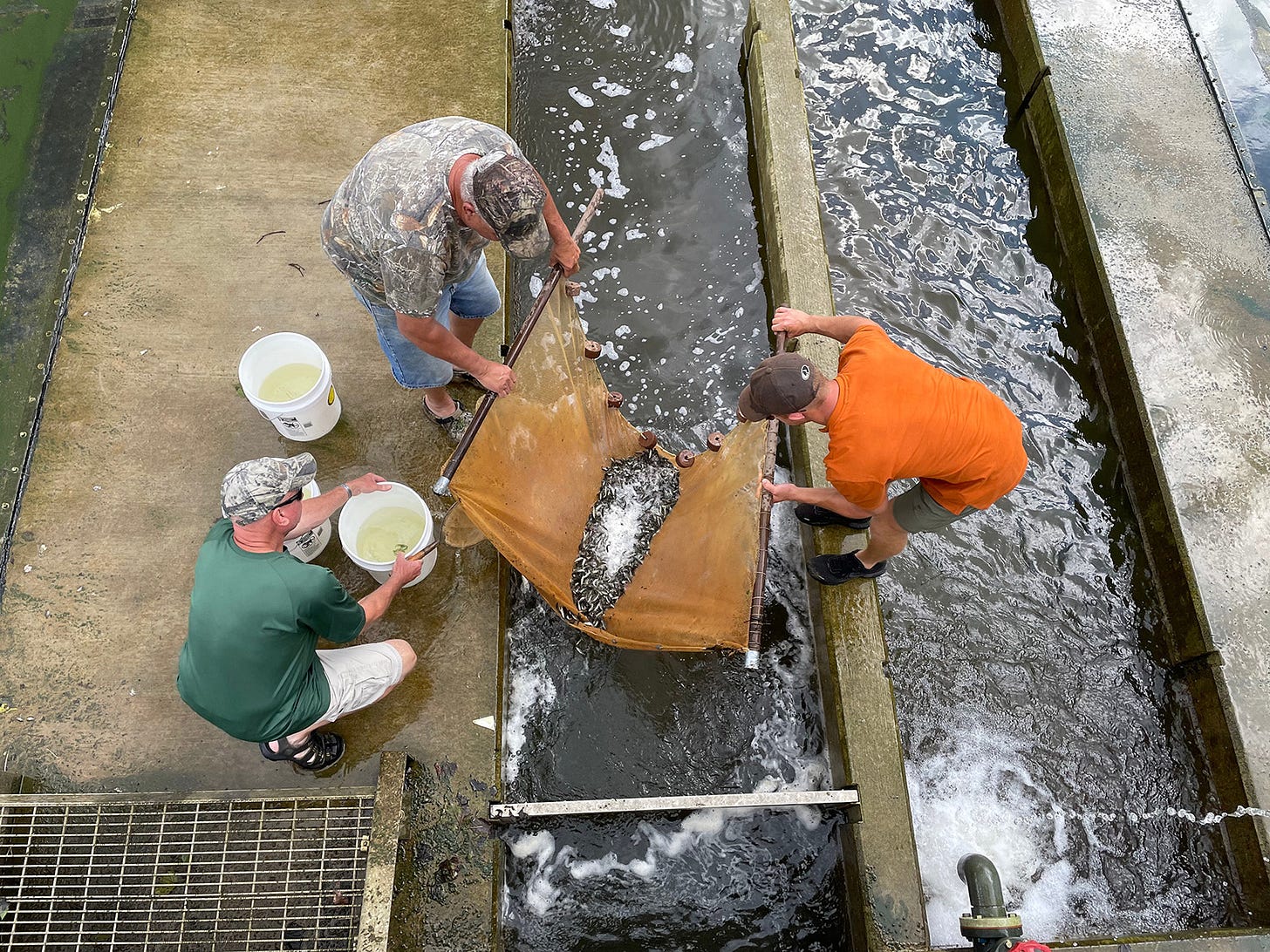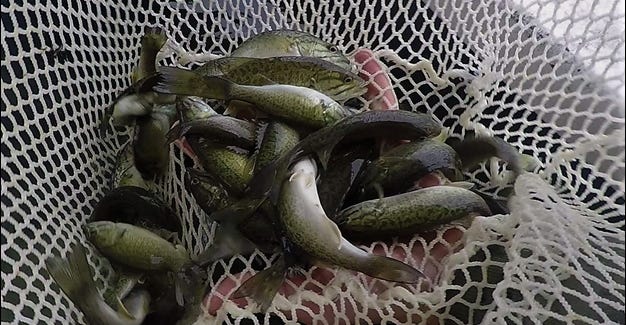When we examine the impacts of the repeated high water events and flood stage events on many of the Mid -Atlantic river systems this Spring one of the biggest question and challenge is examining just what the impact will be on the 2025 Smallmouth spawning cycle.
I am a firm believer after fishing these river systems my whole life that the Smallmouth do not merely spawn just one time. We routinely see fry in the mid Spring but also in mid summer especially in rivers like the Upper Potomac, Monocacy, Allegheny and the James River. All of these can be impacted by high water and flood stage events and its my contention that multiple spawns may simple be evolutionary response in nature as bass become accustomed to high water levels in the Spring and adapt. (Pic: Maryland Department of Natural Resources)
We must first begin by examining what we know about the spawn itself. Lets divce into the biology of the Smallmouth Bass (Micropterus dolomieu) spawning process in Mid-Atlantic river systems, with comparisons to their Largemouth Bass cousins and other Black Bass species.
Smallmouth Bass Spawning Process in River Systems (Mid-Atlantic Region)
1. Spawning Season Overview – Timing & Water Conditions
Timing:
Typically begins in late April through May in Mid-Atlantic rivers (e.g., Susquehanna, James, Shenandoah).
Spawn initiation depends on water temperatures stabilizing between 58–65°F (14–18°C).
Water Clarity Preference:
Prefer clear to moderately stained water.
Visual spawners: need clarity to assess beds and predators.
Flow Conditions:
Need stable or gradually declining river flows.
Flooding or rapid flow changes can disrupt nests and lower fry survival.
2. Spawning Locations – Smallmouth vs. Other Black Bass
✅ Smallmouth Preferences:
Gravel or coarse sand substrate
Shallow flats near current seams or downstream of islands
2–6 feet depth, often with some current
Often closer to main river channels than Largemouth
How Smallies Differ from Largemouth Bass:
Largemouth prefer muddy or silty backwaters, ponds, or bays
Largemouth spawn in slower water, often with vegetation
Largemouth tolerate warmer, more turbid conditions (spawn begins at ~62–65°F and up)
3. Spawning Behavior & Male-Female Interaction
Sequence of Events:
Male Construction:
Male selects and fans out a circular nest using fins, usually 12–24 inches wide.
Cleans the substrate of silt and debris.
Courtship:
Male courts passing females with circular swimming, nudging, and display.
If accepted, the female enters the nest.
Spawning:
The pair align and release eggs and milt simultaneously.
Multiple passes may be made over several hours or days.
Female Departure:
Once spawning is complete, the female leaves.
Male remains to guard eggs and fry.
4. Nesting Duration and Male Role
Egg incubation: ~5–10 days, depending on temperature
Fry remain in nest: 3–5 days after hatching
Male guards nest: Total of 10–14 days, longer if flow or predator pressure is high
Male fends and defends females from:
Sunfish, darters, minnows, crayfish, other bass
🛑 Male populations are a critical component. Females may spawn multiple times but its generally accepted that males will only engage in spawning once per season which means if a river system is dominated by males there may fresult in mutiple spawns with females interacting with additional males who have not yet engaged with a female.
*********************************************************************************************************
🎉 Father's Day Sale 🎁— Our partner Power Queen is running great Father Day Sales on Batteries for all your needs. From Trolling Motor to Camping and RV!!
Use our subscriber code for deeper discounts here:
https://ipowerqueen.com/?ref=smalliechaser
*************************************************************************************************************
5. Reproductive Metrics & Survival Rates
🎯 Fecundity:
A female may lay 2,000–15,000 eggs, depending on size and health
📊 Biologist Goals for Year-Class Success:
Egg-to-fry survival: ~20–50% under ideal river conditions
Fry-to-juvenile survival: Often <5% in natural rivers
Recruitment success varies yearly, often tied to:
Stable flows
Moderate temperatures
Minimal siltation
📉 High spring floods or silt loads often wreak havoc on Smallmouth populations and have been known to totally wipe out entire spawning classes in river systems.
6. Post-Spawn Behavior & Dispersal
Males:
Exhausted, lose weight, and move to deeper pools or slow current areas to recover
Typically inactive for 7–10 days post-guarding
Females:
Often feed aggressively post-spawn
Move to mid-depth rocky breaks, eddies, or transition zones
Post-Spawn Movement:
Most Smallmouth remain within a mile of spawning area
Some migrate upstream or downstream based on forage, flow, and temperature
7. Fry Development & Behavior
Fry Life Cycle:
Hatch within 5–10 days
Swim-up fry stay near the nest, protected by male for 3–5 days
Once male leaves, fry become schooling and pelagic for several weeks
📏 Growth:
Grow ~1–2 inches by late summer
First-year mortality is high due to predators (sunfish, herons, larger bass, etc.)
Schooling Behavior:
Fry stay grouped for 2–4 weeks post-hatch
Then begin dispersing into shallow vegetated margins, root wads, and slack water zones
8. Summary – Smallmouth Spawn Biology
Smallmouth Bass Largemouth Bass
Spawn Temp 58–65°F 62–70°F
Water Type Clear, gravel, current nearby Warm, still, muddy
Nesting Site Gravel, near flow Mud, slow water
Parental Role Male guards nest and fry Same
Spawns per Year 1 (Usually) But+1 1
Fry Behavior School temporarily Similar to Smallies
River Impact Flow-sensitive Less sensitive to current
What we have experienced in 2025 points to a very limited initial success rate for the this years spawning class in multiple river systems as a direct result of the extended high water levels and flood stage events that took rivers like the Upper Potomac and James River above 20 feet at multiple gauges right in the middle of the optimum water temps for the spawn the last two months.
Two high water events in quick succession overwhelmed river systems that are just now as we enter June are just getting back to normal levels. The impact will not be known in reality until the next survey results conducted by state agencies in the rivers and often we don’t really know for a number of years how bad or great a spawn actually was in any given season.
State agencies have pushed the notion that the Smallmouth Bass population has been negatively impacted by high water events since 2020 but often times these are only supported by limited electro survey events conducted. These surveys often are conducted in the same places and one thing we have come to release the last decade is that Smallies move much further than we previously believed. We are learning this not only from catches from both wade and kayak anglers the past few years as more and more have been targeting Smallies on our rivers since Covid but also from private tagging programs.
State agencies like in Virginia conduct studies over longer period of time. One such study is a five year dedicated study examining impact of stocked Smallies bred from state hatcheries upon Virginia's smallmouth populations. It is estimated that over 30,000 fingerlings were released with fin clips to track development and contribution to the overall fishery health. Anglers may come actually catch some of these tagged or clipped fish in the years to come.
Another such program can be found online at Fishtagged.com. This program is being conducted by multiple river anglers on the Upper Potomac where they have tagged and tracked over 2,000 river smallies. Many of these fish tagged are being re caught by anglers demonstrating how some have moved upwards of 15 miles from their previous catch or release point. This kind of real movement data contradicts what many of us have long though about how far bass will move in our rivers.
We will certainly get an idea of how high water may impact not only spawn but also movement for Smallies once more get caught this summer after all these events during the Spring. (Pic- Maryland Department of Natural Resources)
Resources:
Contact:
smalliechaserriverbassin@gmail.com
You Tube:
Smallie Chaser River Bassin:
You Tube: https://www.youtube.com/@TheSmallieChaserChannel
J.L. Scott Fishing
You Tube: https://www.youtube.com/@J.L.ScottFishing
Kayak Fishing Event/Wade Fishing Event:
TourneyX: Clubs Tab (Virginia) Tournament Fishing App
https://tourneyx.com/app/category/va---smallie-chaser-river-bassin
Community:
DISCORD: Free To Join (Smallmouth)
https://discord.gg/KtpkAJchUP








I remember reading that 1972’s Hurricane Agnes had such high flood levels that the smallmouth population was set-back for from 4-6 years. Frequently waded just below the pipelines & always caught 10-15 a day (1964-1971).